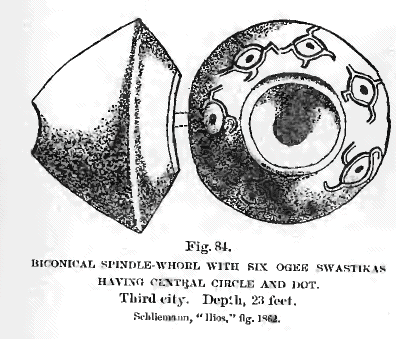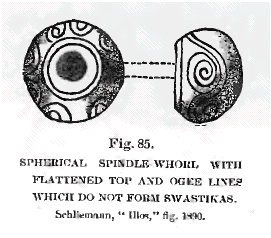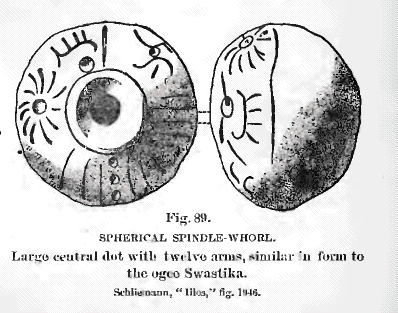

The Swastika
Dispersion of the Swastika
of The Swastika
sign to other signs, whether cross or circle. The outer parts of the field
are occupied with the parallel lines of the circle segment, as shown in
many other specimens. The specimen shown in fig. 84 is similar in style
to the last. The

bodies of six Swastikas are
formed by a circle and dot, while the arms of the cross start from the
outside of the circle, extending themselves in curves, all of them to
the right. (See fig. 13d.)
It has no other ornamentation. The same remark is to be made about the
indifferent use of the Swastika in association with cross or circle. We
have seen many swastikas composed of the crossed ogee lines or curves.
Figs. 85 and 86  show
the same ogee lines and curves not crossed; and thus, while it may be
that neither of them are Swastikas, yet they show a relationship of form
from which the derivation of a Swastika would be easy.
show
the same ogee lines and curves not crossed; and thus, while it may be
that neither of them are Swastikas, yet they show a relationship of form
from which the derivation of a Swastika would be easy.
Attention has been called to decorations comprising segments of the circles incised in these whorls, the periphery of which is toward their centers (figs. 60, 64, 65, 69, 70, 82 and 83). Also to the mysterious dots (figs, 46, 56, 75, 76, 77, 79, 84, 92, 96 and 97). Fig. 87 shows a combination of the segments of three circles, the dots within each, and two Swastikas. Of the Swastikas, one is normal, turning to the right; the other turns to the right, but at an obtuse angle, with one end straight and the other irregularly curved. Fig. 88 represents two sections of a terra-cotta sphere divided similar to fig. 49. Each of these sections contains a figure like unto a Swastika and which may be related to it. It is a circle with arms springing from the periphery, which arms turn all to the left, as they do in the ogee Swastika. One has seven, the other nine arms. One has regular, the other irregular, lines and intervals. Fig. 89 represents a spindle-whorl of terra cotta nearly spherical, with decoration
of a large central dot and lines springing thereout, almost like the spokes
of a wheel, then all turning to the left as volutes. In some countries
this has been called the sun symbol, but there is nothing to indicate
that it had any signification at Hissarlik. One of the marks resembles
the long-backed, four-legged animal (figs.
99 and 100). (1)
Figs. 90, 91,
92, and 93
show a further adaptation of the ogee curve developed into a Swastika,
in which many arms start from the center circle around the central hole
in the whorl, finally taking a spiral form. The relation of this to a
sun symbol is only mentioned and not specified or declared. The inexplicable
and constantly recurring dots are seen in fig.
90. It is not contended that these are necessarily evolutions of the
Swastika. We will see father on many lines and forms of decoration by
incised lines on these Trojan whorls, which may have had no relation to
the Swastika, but are inserted here because persons rich in theories and
brilliant in imagination have declared that they could see s resemblance,
a relation, in this or some other decoration. As objects belonging to
the same culture, from the same locality, and intimately associated with
unmistakable Swastikas, they were part of the res gestæ,
and as such entitled to admission as evidence in the case. The effect
of their evidence is a legitimate subject for discussion and argument.
The refuse these figures admission would
decoration
of a large central dot and lines springing thereout, almost like the spokes
of a wheel, then all turning to the left as volutes. In some countries
this has been called the sun symbol, but there is nothing to indicate
that it had any signification at Hissarlik. One of the marks resembles
the long-backed, four-legged animal (figs.
99 and 100). (1)
Figs. 90, 91,
92, and 93
show a further adaptation of the ogee curve developed into a Swastika,
in which many arms start from the center circle around the central hole
in the whorl, finally taking a spiral form. The relation of this to a
sun symbol is only mentioned and not specified or declared. The inexplicable
and constantly recurring dots are seen in fig.
90. It is not contended that these are necessarily evolutions of the
Swastika. We will see father on many lines and forms of decoration by
incised lines on these Trojan whorls, which may have had no relation to
the Swastika, but are inserted here because persons rich in theories and
brilliant in imagination have declared that they could see s resemblance,
a relation, in this or some other decoration. As objects belonging to
the same culture, from the same locality, and intimately associated with
unmistakable Swastikas, they were part of the res gestæ,
and as such entitled to admission as evidence in the case. The effect
of their evidence is a legitimate subject for discussion and argument.
The refuse these figures admission would
ENDNOTES:

 show
the same ogee lines and curves not crossed; and thus, while it may be
that neither of them are Swastikas, yet they show a relationship of form
from which the derivation of a Swastika would be easy.
show
the same ogee lines and curves not crossed; and thus, while it may be
that neither of them are Swastikas, yet they show a relationship of form
from which the derivation of a Swastika would be easy. Attention has been called to decorations comprising segments of the circles incised in these whorls, the periphery of which is toward their centers (figs. 60, 64, 65, 69, 70, 82 and 83). Also to the mysterious dots (figs, 46, 56, 75, 76, 77, 79, 84, 92, 96 and 97). Fig. 87 shows a combination of the segments of three circles, the dots within each, and two Swastikas. Of the Swastikas, one is normal, turning to the right; the other turns to the right, but at an obtuse angle, with one end straight and the other irregularly curved. Fig. 88 represents two sections of a terra-cotta sphere divided similar to fig. 49. Each of these sections contains a figure like unto a Swastika and which may be related to it. It is a circle with arms springing from the periphery, which arms turn all to the left, as they do in the ogee Swastika. One has seven, the other nine arms. One has regular, the other irregular, lines and intervals. Fig. 89 represents a spindle-whorl of terra cotta nearly spherical, with
 decoration
of a large central dot and lines springing thereout, almost like the spokes
of a wheel, then all turning to the left as volutes. In some countries
this has been called the sun symbol, but there is nothing to indicate
that it had any signification at Hissarlik. One of the marks resembles
the long-backed, four-legged animal (figs.
99 and 100). (1)
Figs. 90, 91,
92, and 93
show a further adaptation of the ogee curve developed into a Swastika,
in which many arms start from the center circle around the central hole
in the whorl, finally taking a spiral form. The relation of this to a
sun symbol is only mentioned and not specified or declared. The inexplicable
and constantly recurring dots are seen in fig.
90. It is not contended that these are necessarily evolutions of the
Swastika. We will see father on many lines and forms of decoration by
incised lines on these Trojan whorls, which may have had no relation to
the Swastika, but are inserted here because persons rich in theories and
brilliant in imagination have declared that they could see s resemblance,
a relation, in this or some other decoration. As objects belonging to
the same culture, from the same locality, and intimately associated with
unmistakable Swastikas, they were part of the res gestæ,
and as such entitled to admission as evidence in the case. The effect
of their evidence is a legitimate subject for discussion and argument.
The refuse these figures admission would
decoration
of a large central dot and lines springing thereout, almost like the spokes
of a wheel, then all turning to the left as volutes. In some countries
this has been called the sun symbol, but there is nothing to indicate
that it had any signification at Hissarlik. One of the marks resembles
the long-backed, four-legged animal (figs.
99 and 100). (1)
Figs. 90, 91,
92, and 93
show a further adaptation of the ogee curve developed into a Swastika,
in which many arms start from the center circle around the central hole
in the whorl, finally taking a spiral form. The relation of this to a
sun symbol is only mentioned and not specified or declared. The inexplicable
and constantly recurring dots are seen in fig.
90. It is not contended that these are necessarily evolutions of the
Swastika. We will see father on many lines and forms of decoration by
incised lines on these Trojan whorls, which may have had no relation to
the Swastika, but are inserted here because persons rich in theories and
brilliant in imagination have declared that they could see s resemblance,
a relation, in this or some other decoration. As objects belonging to
the same culture, from the same locality, and intimately associated with
unmistakable Swastikas, they were part of the res gestæ,
and as such entitled to admission as evidence in the case. The effect
of their evidence is a legitimate subject for discussion and argument.
The refuse these figures admission would 1. "Ilios" p. 418. [Back]
2. See p. 786
<< Previous Page Next Page >>
© 2004-2007 Northvegr.
Most of the material on this site is in the public domain. However, many people have worked very hard to bring these texts to you so if you do use the work, we would appreciate it if you could give credit to both the Northvegr site and to the individuals who worked to bring you these texts. A small number of texts are copyrighted and cannot be used without the author's permission. Any text that is copyrighted will have a clear notation of such on the main index page for that text. Inquiries can be sent to info@northvegr.org. Northvegr™ and the Northvegr symbol are trademarks and service marks of the Northvegr Foundation.

|